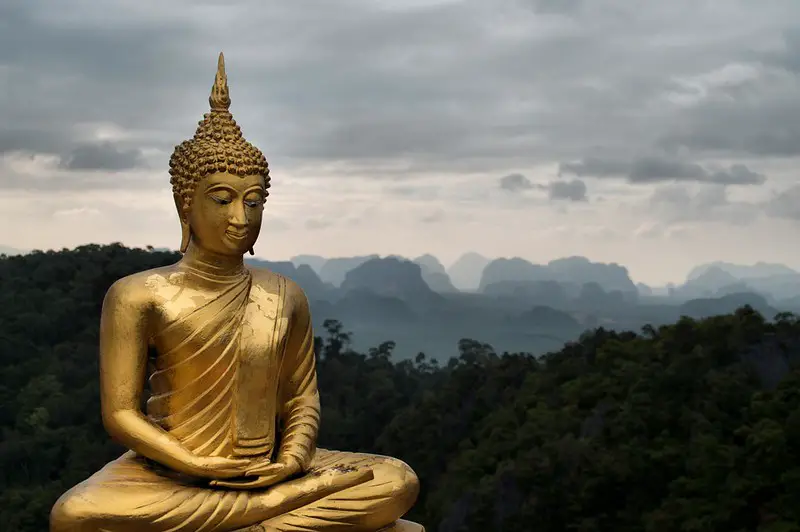In life, what’s your purpose? Perhaps it’s about fulfilling your dream career, starting a family, or exploring the globe. Maybe it is a blend of all three. Yet satisfaction is an aim in itself for all of us.
Throughout history, individuals have wandered miles over sandy plains through diverse cultures and religious and spiritual practices and ascended the rockiest mountains to achieve enlightenment, that is, the highest point of human potential. These individuals were attempting to become as smart, powerful, caring, and content as they could be. But the road wasn’t always convenient there.
In this outline, after focusing on a seven-step path of enlightenment, we will take a look at how to achieve real happiness and contentment.
Using the neurodharma technique of writer Rick Hanson, which blends contemporary neuroscience with insights from the Buddhist philosophy of Theravada, we will look at activities to become more conscious, healthy, and linked to the universe.

Chapter 1 – There are seven types of being that form the base of actual enlightenment.
You know how difficult it can be if you’ve ever climbed up a hill. Not only is it physically challenging, but along the way to the highest point, there are also hurdles and obstacles.
Well, that’s what it’s like to gain joy, intelligence, and strength – the writer’s “heights of human potential” attributes.
We may all wish to hit these peaks, the mountain’s symbolic peak, but we must initially walk a road of enlightenment to get there.
There are several religious or philosophical practices with their interpretations of how to ascend to satisfaction on the mountain. But all of them, solidity, lovingness, richness, fulfillment, novelty, allness, and timelessness, seem to follow the same seven stages. Perfecting these seven ways of becoming leads, better known as full awakening, to enlightenment.
Three types of meditation are interested in creating a deeper sense of fullness, wholeness, or some other dimension of awakening: Let be, let go and let in. Let’s look more closely one by one at these.
First one, let be.
You may find a variety of thoughts and feelings growing inside you as you embark on your journey to awakening. Learning to let be involves embracing these emotions as they appear, and trusting yourself to experience them with all your heart.
Next up, let go, meaning to release what is unpleasant or negative. In the body, this may come in the form of relieving discomfort, venting bad feelings, or disassociating yourself from impulses that harm you or others.

It’s let in, last. You should substitute them with the positive until you’ve replaced all negative thoughts or feelings. For example, you could work on learning new abilities if you’ve not performed well on a task, or on being more thankful and resilient after getting negative comments.
Look at this way: you can take out the weeds and grow flowers in their spot if your brain is like a greenhouse.
So creating the seven ways of being calls for you to freely encounter emotions, embrace them, and let them be. You teach yourself to be more conscious, caring, and happy as you do this.
We’ll glance at how to implement these seven steps to awakening in our daily lives in the following pages. But first let’s explore the neuroscience underlying awakening, and how our minds can be rewired to maximize our health.
Chapter 2 – Our psychological health can be enhanced by modifying our neuronal function.
Have you ever questioned why coffee is something we can taste? How do we know where we placed our keys? During a divorce, what is the reason why we feel so overwhelmingly sad?
Well, it comes down to our nervous system – and the brain, its center. Our every emotion, each perception, and each wish are based upon neural activity.
Researchers have shown that there is a connection between what we experience and what our brains perform, and this link can be utilized in realistic ways.
Our brains are composed of 85 billion connected neurons in an immense network. So when you read or listen to these sections, neurons, for instance, beat together in unison, or the cells that pass information throughout the body. This produces electrical activity waves that are perceived by our neural receptors as letters or noise.
But how can this neuronal process be regulated by us? Using mindfulness and meditation, both of which have been found to have brain-changing results, is the safest approach.

In reality, over extended periods, people who practice meditation gain better control over their amygdala. This is the almond-shaped area that plays a vital role in the transmission of perceptions and feelings near the middle of the brain.
The amygdala also functions as a warning clock against something unpleasant or menacing. Your amygdala causes a hormonal stress reflex if an upset face approaches you in the street, or you get terrible news after your annual checkup. So it can also help relieve tension and reduce outbursts and have greater control over it.
It is where meditation can aid! In their heads, experienced meditators who have had thousands of hours of lifelong practice experience profound long-term improvements.
Take, for instance, the veteran members of Tibetan Buddhism. They have insane levels of brain-wave gamma-range activation, which is consistent with increased learning. When preparing themselves for discomfort, these meditators often show a surprising composure, and they heal rapidly after.
We have found that meditation can facilitate brain neuronal improvements that contribute to higher tolerance and overall well-being. It goes a lot farther than that, however.
Your brain “takes its form” from what you devote your energy to according to new studies. So you’ll weave these attributes into your nervous system by using meditation to cultivate a deeper sense of stability, lovingness, and the other five forms of being.
Chapter 3 – The first step towards enlightenment, which allows one to focus while meditating, is to stabilize the mind.
He didn’t take it too seriously when the writer first started to meditate.
He was just obtaining his university degree, and a rising thing happened to be meditation. After school, with his long hair and wooden flute, he would lie in the Southern California mountains, pretending to appear like he was meditating.
However, after training a couple of times, he knew something serious was occurring. He felt a sense of peace, silence, and “untroubled awareness” washed over him as he closed his eyes and started to breathe gently.
Several years later, in a meditation class, the writer finds himself explaining these encounters. His teacher’s reaction? “What about focus, though?”
A crucial element of stabilizing the mind is understanding how to center our attention—the first step on the road to enlightenment.
One of the three foundations of Buddhist meditation is the focus. It improves our concentration and allows us to reflect deeply on our practice of meditation. When we have a very sharp focus, we give ourselves up to deep wisdom.

The issue is that we are continually being bombarded by disruptions from contemporary life, from our devices buzzing off the hook to job emails appearing at all times in our inboxes. And the challenge isn’t just technology. Our partnerships, families, and even health conditions will derail our focus, leaving us less capable of focusing on the tasks before us.
We need to develop synaptic mechanisms that encourage focus and steadiness in the mind to relax this “monkey mind.” Via meditation, we can do that. So let’s have a glance at a common exercise with concentrated attention.
Start by focusing on a single object of interest. You might concentrate, for instance, on the picture of a buoy in a warm tropical sea. Or could reflect on your breath, the rise and fall of your chest as it rises and flattens, and the air flowing in and out of your nose and mouth.
Other ideas, feelings, and pictures can spontaneously pop up into consciousness during meditation. Work to stop interacting with them. Alternatively, direct your roaming mind back to your point of concentration.
And if it feels daunting initially, over the practice, the concentration can grow steadier. The mind is like a muscle: the longer we exercise it the more it gets stronger.
Chapter 4 – Living with a generous heart involves being kind to yourself and others.
At the Spirit Rock Meditation Center in Woodacre, California, in the early 2000s, the writer participated in a meeting. He went to hear the speech of the Dalai Lama.
Although the Dalai Lama said a variety of informative things the writer only recalls his security guard. He stood at rest like a performer in the conference, laughing at everyone in the hall. There was no sense of danger from him even though he was there to protect the Dalai Lama and was equipped to use force if needed. He radiated pleasure and affection instead.
The road to enlightenment may also appear based on the internal realm of the person. Yet many of the components are simply interpersonal.
Part of being satisfied in Buddhism, in which society is important, means being respectful and caring to others and making them satisfied too. This is what the writer calls warming the heart, the second phase of enlightenment.
Via compassion-focused practice, we will nurture the virtues of goodness and empathy. It stimulates the portions of the brain that elicit positive feelings and enable us to communicate with others.

The Theravada Buddhist practice derives from one of the writer’s favorite rituals for this meditation. It includes supplying five types of persons with four kinds of supportive wishes.
The four wishes are to be “safe, healthy, happy, and at ease” with ourselves and others. And the five kinds of people who will obtain them are a beneficiary, that is, someone we admire, a friend, a neutral person, someone who is unpleasant to be with, and, finally, ourselves.
Here’s how things work.
Be mindful of the body initially: visualize the air that flows in and out. Select a beneficiary, then. Concentrate on the warm feeling inside you that an individual inspires. Then repeat to yourself these words: ‘May you be protected, may you be well, may you be content, may you live easily.’
If your mind shifts to bad situations or problems, it’s fine. Only place your attention back on the feeling of being with the person you care for. Then do this again with a friend, a troublesome person, and so on.
The road to enlightenment is not one that we walk on our own. It includes the formation within ourselves of constructive ideas, emotions, and desires that we then channel to the broader world.
Chapter 5 – By practicing the art of resting in contentment, we will cure our pain.
Early on in his life, the writer learned that frustration is normal, and it can come in many forms. Some people, while others feel slightly unaccomplished, live their life experiencing the constant pain of trauma.
These perceptions are what Buddha himself called misery, which he described as human existence’s First Noble Truth.
At some time, all of us face pain. Yet in our existence, some of us bear the weight of pain. And often the strain may be too much to handle.
A great deal of our pain comes from yearning. This is the feeling that, as if a desire has not been fulfilled, something is absent from our existence. In all sorts of ways, like pursuing happiness, dulling pain, or sticking to partnerships that don’t support us, the craving will manifest itself.
However, there’s a saving grace. The principles of Buddhism instruct us that we will free ourselves from temptation and thus from pain. By relaxing in fullness, which is the third phase on the journey towards enlightenment, we will achieve this.

The HEAL acronym follows one procedure for resting in fullness. Substituting negative material with positive material is involved. The negative stuff may be, for instance, the painful recollection of having been left out of something as a boy. And the optimistic stuff may be the relaxed feeling of a community of friends included in it.
Let’s get started at the top.
First, we begin with H, which is to have a good material interaction. Essentially, this involves taking your attention to the moment and location when you felt these feelings of pleasure.
Next, by sticking with the memory, the E guarantees you enrich the feeling. Enable yourself, in your body, to experience it.
So the positive stuff is absorbed by the A. Envision it settling inside you like the warm, calming rays of the sun. Also, be careful about why it feels nice.
Finally, the difficult component is the L: the positive stuff is related to the negative stuff. Do this by getting into the mind the negative content while still firmly and strongly retaining the positive stuff. Then, let go of the negativity after a couple of breaths. Envision it shrinking like an air balloon.
The art of feeling happy is to settle in plenitude. It allows us to repair past scars so that on the road to enlightenment we can move on.
Chapter 6 – Enhancing neural factors would allow one to support a sense of fulfillment and to live in the moment.
What does it mean to be actually whole? And will this sensation ever be achieved by anyone?
Wholeness, the fourth stage of enlightenment, is achieved by completely embracing oneself, the positive and the evil, and doing so despite the inherent inclination of the mind towards the negative!
Fortunately, once we put in the effort, we will all reach wholeness.
To understand why the brain can make one feel unaccomplished, let’s look at neurology.
Cortical midline networks are accountable! They pass along the centerline of the uppermost regions of the brain and are split into two parts. The front-end network facilitates problem-solving, executing assignments, and making preparations. Ruminating and fantasizing are powered by the default mode network at the back.
Because the brain’s default network drives rumination, during the day we frequently get lost in contemplation. In fact, research suggests that about 50 percent of the time they’re awake, the average individual has a thinking mind!

This thinking can have negative implications, particularly because the brain is opened to self-referential thoughts by the midline networks. The more the mind strolls, the more depression, fear, or self-criticism it will tilt towards.
And how are we going to improve this?
Well, widening the lateral networks of the brain works. Positioned on either side of the brain, these neural networks run against the midline networks, blocking them while they are involved. They also assist with holistic processing, which helps us, like when we glance at a panoramic view, to see the broader image.
Even through tough moments, improving our lateral networks fosters a feeling of fulfillment, and several activities will help us achieve this.
One of them, gestalt perception, facilitates visualization of the entire, cohesive picture of stuff. It can be interpreted seriously, such as when, while driving, we bring consciousness to our entire bodies, or it can be figurative, like when we visualize our minds as a large sky where clouds depict thoughts and emotions.
Practicing gestalt consciousness thus encourages one to take the fifth step towards enlightenment. This implies being present and not thinking about the past or the future in the present.
Perfecting these two steps encourages one to let go of negativity, to become more full within ourselves, and to thrive at the moment, eventually.
Chapter 7 – When we reduce our sense of self and therefore open to allness, well-being rises.
What would you answer if anyone were to ask you what “self” means?
To explain the nature of a human being, many individuals understand the word self, an elusive something that separates one person from another. Such self-related terms like ego, identity, me, and myself.
Look at this way: a self is a sort of being inside you that through your eyes stares out at the world.
The issue is sometimes possessing a good sense of self is what triggers our pain. It lets one individually take things, behave aggressively, and even become possessive of others. That’s why it’s so important to dissolve the notion of self to find happiness.
Let’s focus on what this really entails first.
When the Buddha instructed individuals on the self-release process, he promoted activities that discuss three unique features. The first was to release self-identification or the feeling that “that’s me,” in other terms. The second was to release possessiveness, or “that’s mine.” And the last was to let go of conceit, the belief that “I’m better than you” or “I deserve more than you.”
When we withdraw from the sense of identity, we continue to view the world from the standpoint of “we,” that is, ourselves and those around us, instead of “I.” We will do this by adopting the techniques of opening to allness, which is the sixth step on the road to enlightenment.
We should use meditation, much as the practice of wholeness, to help us communicate with the broader universe.

Try being responsive to how the sensation of I or me arrives or leaves in the body while you meditate. Realize that, regardless of multiple reasons, this sense of self has many various parts that continue to evolve. And try to imagine yourself as being insignificant and cloudlike. Do you remember the deflating balloon picture that we described while letting go of negativity? Try to picture the same thing occurring to you.
Opening activities into allness may also entail items such as stepping into nature. It will help you turn your attention from yourself to the large broad world surrounding you by merely standing in an open lot.
Chapter 8 – To pursue Nibbana, or real pleasure implies recognition of impermanence.
The writer once talked with an instructor called Steve Armstrong, who had studied in Asia as a monk. He was interested to learn more about Nibbana in Buddhism, the supreme spiritual objective.
Nibbana is pure pleasure and freedom from pain and the writer wanted to know what it feels like to achieve that level.
Nibbana, Steve Armstrong answered, is like residing in a small valley surrounded by hills. Then, one day you are standing atop the tallest point, able to see the whole world.
Sadly, you can’t remain there; you have to head back down to the valley at a certain point. But from what you have seen, you are completely changed.
The last step on the road to discovering Nibbana is to pursue timelessness, and it’s the toughest stage.
Much as an eddy, a transient current of water that creates fleeting ripples, being comfortable and often free from pain means understanding that something is impermanent.
An eddy, by definition, is a sequence of something stationary until it disperses for a short period. For starters, a cloud is an atmospheric eddy, and in a partnership, a dispute is an eddy. Ultimately, all eddies disperse.
It requires letting go of painful feelings and pain and thinking about the future, to find timelessness. And the reflection that follows will assist with this.

Sit in a relaxed place, as always, and relax inside your body. As well as any emotions and feelings that may occur, be mindful of your pulse. Then reflect on an encounter you’ve had, or might have had in the future, and cause your consciousness to shift.
Much like an eddy in a sea, consider the numerous trends of knowledge flowing through your awareness. Enable your emotions, looping in and out to swirl along.
Be mindful of the existence of these experiential eddies: they are transitory and devoid of essence.
When you do this, continue to understand that being an open process is your existence as a human being. Things are going to change, fall apart, and slip away—just let life take you along.
The equivalent to having full enlightenment is discovering Nibbana, and many of us will never get there. However, it will put you on the right path by actually practicing stability, lovingness, fullness, wholeness, novelty, allness, and timelessness in your daily life.
Neurodharma: New Science, Ancient Wisdom, and Seven Practices of the Highest Happiness by Rick Hanson Book Review
The seven ways of being offered a blueprint for how to happily and comfortably to spend your life. They will help you cope with depression, cure past suffering, and give yourself and others more love and compassion. Meditation is an important instrument that can assist you in cultivating these forms of being. And daily practice will lead to physiological improvements, strengthen your mental health, and help you learn to live here and now.
Enjoy this ride.
It’s no easy feat to find real happiness. There’ll be a lot of obstacles on the route, and moments when you may want to give up completely. Simply to keep driving is a critical aspect. While you may never hit the peak of the real enlightenment hill, the most significant thing is to start on the trip.
Try Audible and Get Two Free Audiobooks
